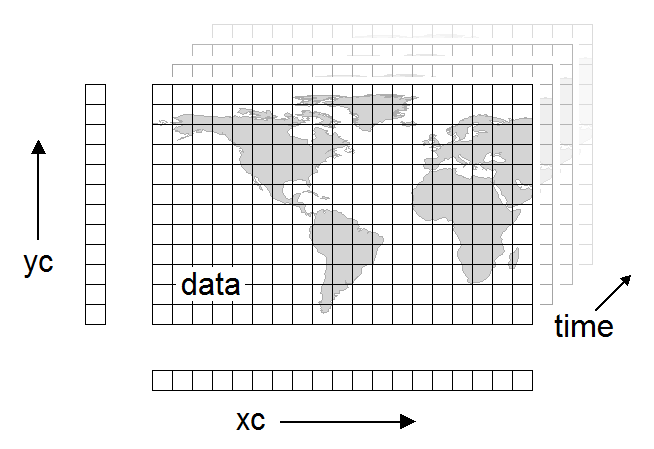
| North American Regional Climate Change Assessment Program |
| NARCCAP User Meeting Handout | |||||||||||||||||||||||||||
NARCCAP Data OverviewNARCCAP data is stored in CF-compliant NetCDF format. Filenames
are of the form
So, for example, Useful Links
NetCDFNetCDF is a data format for storing array-oriented scientific data, particularly geophysical data. It is highly portable, widely-understood, and has built-in metadata that makes the files self-describing.
The main data array has associated coodinate arrays, xc, yc, and time, for each of its dimensions. Time is an unlimited or record dimension (important for some tools). Each variable in a NetCDF file can have attributes associated with it. NetCDF Headerpr_WRFP_1979090103.nc.head.txt
-- produced by ncdumpOutputs contents of a netCDF file as ascii. From Unidata, part of the NetCDF libraries. http://www.unidata.ucar.edu/software/netcdf/index.html Useful options:
Example output: pr-ncdump.csv -- produced using NCONCO is a package of command-line utilities for manipulating netCDF files. Each NCO command does one very specific kind of manipulation, but you can combine them to powerful effect. There are a number of options common to most or all NCO commands. These include -v for specifying the variable and -d for choosing a dimensional slice. Some NCO commands make use of a "record" dimension. This needs to be the first dimension and is unlimited in extent. In NARCCAP data, this is always the time dimension. NCO Documentation: http://nco.sourceforge.net/nco.html
Exampleseasonal-average -- Shellscript using NCO commands to generate seasonal climatology NCLNCL is an interpreted programming language for scientific analysis and visualization. It is designed with NetCDF in mind and allows easy and transparent access to NetCDF data files. It has a large and powerful plotting library oriented toward geophysical data. NCL's syntax is FORTRAN-like. It supports the idea of coordinate variables and attributes associated with variables. Most parameters are passed to functions via "resource" attributes. Examples2d-time-plot.ncl Plot a timeslice from a file. Used in NARCCAP QC process. Example results. Extensive reference and support materials are available on the NCL website: http://www.ncl.ucar.edu/
Other ToolsThere are a number of other tools for working with netCDF data.
GISImporting NARCCAP Data into GIS DownloadingData Download Walkthrough |






